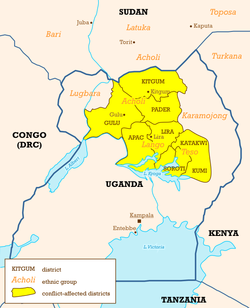As of May 2025, Uganda's refugee program faces several challenges. Funding cuts, in part due to US President Donald Trump's dismantling of USAID, have led to severe cuts in food rations, which have dropped below $8 per person per month. [30] Over the last decade, UNHCR funding for refugees in Uganda has fallen while the number of refugees has risen. [4] In 2015, UNHCR's per capita spending on refugees in Uganda was $95 — in 2025, it's $36. [4] Camps are also overcrowded, with Nyakabande camp hosting 621% more people than it's built to support. [30]
COVID-19 and Refugees
The novel strain of coronavirus, named COVID-19, first appeared in Wuhan, China, with the earliest case reported on November 17, 2019. [31] By January 13, 2020, the virus had spread from China to Thailand, marking the first case of COVID-19 outside of China. [32] On March 11, 2020, the World Health Organization officially recognized the outbreak of COVID-19 as a pandemic. By this time, the virus had spread to more than 114 countries and had taken the lives of over 4,000 people. [33] As of April 17, 2020, there are almost 2.2 million confirmed cases of COVID-19 worldwide, 55 confirmed cases in Uganda, 4 confirmed cases in South Sudan, and 287 confirmed cases in the Democratic Republic of the Congo. [34] As healthcare professionals and researchers continue to learn more about the virus, various groups have come to public attention as high risk groups. One such group is refugees.
Refugees and otherwise displaced populations are particularly vulnerable because of the conditions in which they live. For example, many refugees live in camps or settlements with incredibly high population density and limited access to basic services. Refugees in camps and settlements also encounter difficulties in accessing reliable and accurate information due to a variety of barriers. Further, refugees around the world heavily rely upon the aid of humanitarian groups, non-governmental organizations, and governments; due to the pandemic, these groups will be focusing their efforts and finances on the virus. [35]
In late March 2020, the Ugandan government announced that it would formally suspend the acceptance of refugees and asylum seekers into the country as the number of confirmed cases increased. [36] Many fear the death toll from COVID-19 in Uganda will increase exponentially should the virus be introduced to the many refugee settlements. In addition, representatives of the United Nations Refugee Agency worry that the conditions of refugee settlements may enable the spread of the virus, as access to water is limited, and current food rations have been cut. [37] Ugandan authorities have recently found it difficult to ensure that refugees are complying with the health and safety guidelines implemented by the government in order to limit the spread of the coronavirus. Musu Ecweru, Uganda's State Minister for Disaster Preparedness, explains that this lack of compliance may be due to the fact that many refugees come from countries where the governments are not trusted; as such, submitting to authority is unusual and difficult. [38]


